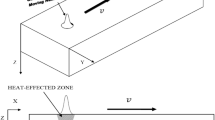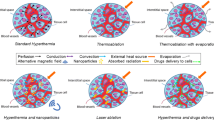Abstract
In the present study, we formulate a boundary value problem that characterizes the light and heat transfer processes in a tissue during a hypothetical superficial hyperthermia therapy. The heating process is represented with a partial differential equations system (PDEs) consisting in the diffusion and bio-heat equations whereas the tissue damage process is modeled with the Arrhenius integral equation. The PDEs system is discretized using the method of lines to obtain an ordinary differential equations system that approximates the original PDEs. The resulting model is then numerically solved to obtain (1) the spatio-temporal distribution of both absorbed light and heat, (2) the volume of tissue effectively treated, and (3) the degree of thermal damage reached. Finally, we define an optimization problem to find a set of relevant parameter values that maximize the therapeutic effect while minimizing damage to healthy tissue. The results of this work could be useful for preclinical level research, in particular for the study of strategies that modify the physical properties of the target tissue for a safe and efficient heat therapy.






Similar content being viewed by others
References
Smith, R.A., Cokkinides, V., von Eschenbach, A.C., Levin, B., Cohen, C., Runowicz, C.D., Eyre, H.J.: American Cancer Society guidelines for the early detection of cancer. Cancer J. Clin. 52(1), 8–22 (2002)
Sakorafas, G.H., Michael, S.: Breast cancer surgery: an historical narrative. Part III. From the sunset of the 19th to the dawn of the 21st century. Eur J. Cancer Care (Engl). 19(2), 145–166 (2010)
Wust, P., et al.: Hyperthermia in combined treatment of cancer. Lancet Oncol. 3(8), 487–497 (2002)
Lee, Henry K., et al.: Superficial hyperthermia and irradiation for recurrent breast carcinoma of the chest wall: prognostic factors in 196 tumors. Int. J. Radiat. Oncol. 40(2), 365–375 (1998)
DuBois, J.B., Hay, M., Bordure, G.: Superficial microwave-induced hyperthermia in the treatment of chest wall recurrences in breast cancer. Cancer 66(5), 848–852 (1990)
Dahl, Olav: Status of clinical hyperthermia. Acta Oncol. 38(7), 863–873 (1999)
Baronzio, G.F., Hager, E.D.: Hyperthermia In Cancer Treatment: A Primer. Springer Science & Business Media, New York (2008)
Franckena, M., Fatehi, D., de Bruijne, M., Canters, R.A., van Norden, Y., Mens, J.W., van der Zee, J.: Hyperthermia dose-effect relationship in 420 patients with cervical cancer treated with combined radiotherapy and hyperthermia. Eur. J. Cancer 45(11), 1969–1978 (2009)
Issels, R.D.: Hyperthermia adds to chemotherapy. Eur. J. Cancer 44(17), 2546–2554 (2008)
Cregan, S.P., Boreham, D.R., Walker, P.R., Brown, D.L., Mitchel, R.E.J.: Modification of radiation-induced apoptosis in radiation-or hyperthermia-adapted human lymphocytes. Biochem. Cell Biol. 72(11–12), 475–482 (1994)
Engin, K.: Biological rationale and clinical experience with hyperthermia. Control Clin. Trials 17(4), 316–342 (1996)
Dewey, W.C.: Interaction of heat with radiation and chemotherapy. Cancer Res. 44(10 Supplement), 4714s–4720s (1984)
Coughlin, C.T., Wong, T.Z., Strohbehn, J.W., Colacchio, T.A., Sutton, J.E., Belch, R.Z., Douple, E.B.: Intraoperative interstitial microwave-induced hyperthermia and brachytherapy. Int. J. Radiat. Oncol. 11(9), 1673–1678 (1985)
Roemer, R.B.: Engineering aspects of hyperthermia therapy. Annu. Rev. Biomed. Eng. 1(1), 347–376 (1999)
Zhang, R., Verkruysse, W., Aguilar, G., Nelson, J.S.: Comparison of diffusion approximation and Monte Carlo based finite element models for simulating thermal responses to laser irradiation in discrete vessels. Phys. Med. Biol. 50(17), 4075 (2005)
Wissler, E.H.: Pennes’ 1948 paper revisited. J. Appl. Physiol. 85(1), 35–41 (1998)
Moritz, A.R., Henriques Jr, F.C.: Studies of thermal injury: II. the relative importance of time and surface temperature in the causation of cutaneous burns. Am. J. Pathol. 23(5), 695 (1947)
Shen, W., Zhang, J., Yang, F.: Modeling and numerical simulation of bioheat transfer and biomechanics in soft tissue. Math. Comput. Model. 41(11), 1251–1265 (2005)
Karaa, S., Zhang, J., Yang, F.: A numerical study of a 3D bioheat transfer problem with different spatial heating. Math. Comput. Simul. 68(4), 375–388 (2005)
Dillenseger, J.L., Esneault, S.: Fast FFT-based bioheat transfer equation computation. Comput. Biol. Med. 40(2), 119–123 (2010)
Fanjul-Vélez, F., Romanov, O.G., Arce-Diego, J.L.: Efficient 3D numerical approach for temperature prediction in laser irradiated biological tissues. Comput. Biol. Med. 39(9), 810–817 (2009)
Sturesson, C., Andersson-Engels, S.: A mathematical model for predicting the temperature distribution in laser-induced hyperthermia. Experimental evaluation and applications. Phys. Med. Biol. 40(12), 2037 (1995)
Mohammed, Y., Verhey, J.F.: A finite element method model to simulate laser interstitial thermo therapy in anatomical inhomogeneous regions. Biomed. Eng. OnLine 4(1), 2 (2005)
Furzeland, R.M., Verwer, J.G., Zegeling, P.A.: A numerical study of three moving-grid methods for one-dimensional partial differential equations which are based on the method of lines. J. Comput. Phys. 89(2), 349–388 (1990)
Khanafer, K., Bull, J.L., Pop, I., Berguer, R.: Influence of pulsatile blood flow and heating scheme on the temperature distribution during hyperthermia treatment. Int. J. Heat Mass Transf. 50(23), 4883–4890 (2007)
Song, C.W., Lokshina, A., Rhee, J.G., Patten, M., Levitt, S.H.: Implication of blood flow in hyperthermic treatment of tumors. IEEE Trans. Biomed. Eng. 1, 9–16 (1984)
Fujita, S., Tamazawa, M., Kuroda, K.: Effects of blood perfusion rate on the optimization of RF-capacitive hyperthermia. IEEE Trans. Biomed. Eng. 45(9), 1182–1186 (1998)
Hager, E.D.: Locoregional hyperthermia. In: Hyperthermia in Cancer Treatment: A Primer, pp. 167–182. Springer, New York (2006)
Niemz, M.H.: Laser-Tissue Interactions: Fundamentals and Applications. Springer Science & Business Media, New York (2007)
Fasano, A., Hömberg, D., Naumov, D.: On a mathematical model for laser-induced thermotherapy. Appl. Math. Model. 34(12), 3831–3840 (2010)
Sun, J., Zhang, A., Xu, L.X.: Evaluation of alternate cooling and heating for tumor treatment. Int. J. Heat Mass Transf. 51(23), 5478–5485 (2008)
Welch, A.J., Van Gemert, M.J. (eds.): Optical-Thermal Response of Laser-irradiated Tissue, vol. 1. Plenum Press, New York (1995)
Shampine, L.F., Reichelt, M.W.: The matlab ode suite. SIAM J. Sci. comput. 18(1), 1–22 (1997)
Fletcher, R., Powell, M.J.: A rapidly convergent descent method for minimization. Comput. J. 6(2), 163–168 (1963)
Liu, D.L., Andersson-Engels, S., Sturesson, C., Svanberg, K., Håkansson, C.H., Svanberg, S.: Tumour vessel damage resulting from laser-induced hyperthermia alone and in combination with photodynamic therapy. Cancer Lett. 111(1), 157–165 (1997)
Honda, N., Ishii, K., Terada, T., Nanjo, T., Awazu, K.: Determination of the tumor tissue optical properties during and after photodynamic therapy using inverse Monte Carlo method and double integrating sphere between 350 and 1000 nm. J. Biomed. Opt. 16(5), 058003–058003 (2011)
Crochet, J.J., Gnyawali, S.C., Chen, Y., Lemley, E.C., Wang, L.V., Chen, W.R.: Temperature distribution in selective laser–tissue interaction. J. Biomed. Opt. 11(3), 034031–034031 (2006)
Acknowledgments
The author’s work was supported by Administrative Department for Science, Technology and Innovation, and the Deanship for Engineering Students, Universidad de Los Andes.
Thanks Hernán Estrada for conceiving the original idea for this project.
Author information
Authors and Affiliations
Corresponding author
Rights and permissions
About this article
Cite this article
Quintero, M.C., Cordovez, J.M. Looking for an Efficient and Safe Hyperthermia Therapy: Insights from a Partial Differential Equations Based Model. Differ Equ Dyn Syst 25, 137–150 (2017). https://doi.org/10.1007/s12591-015-0256-8
Published:
Issue Date:
DOI: https://doi.org/10.1007/s12591-015-0256-8




